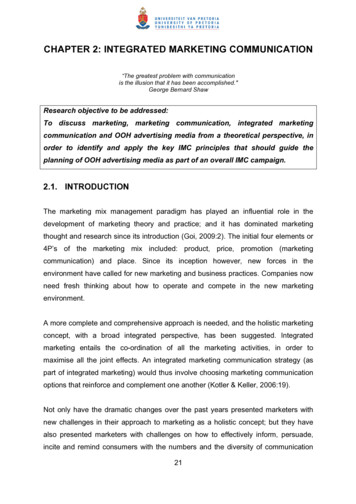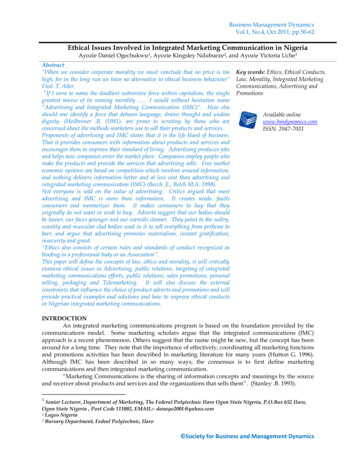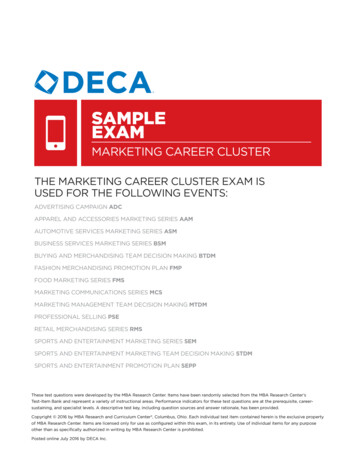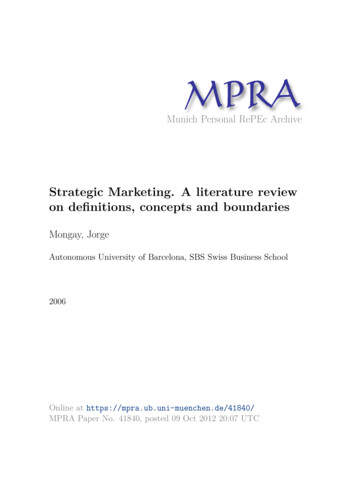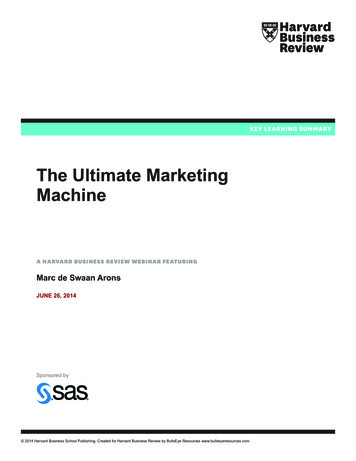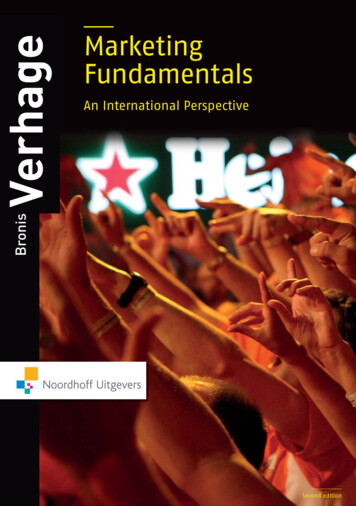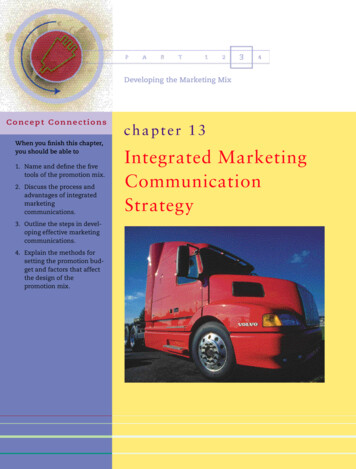
Transcription
Developing the Marketing MixConcept ConnectionsWhen you finish this chapter,you should be able to1. Name and define the fivetools of the promotion mix.2. Discuss the process andadvantages of integratedmarketingcommunications.3. Outline the steps in developing effective marketingcommunications.4. Explain the methods forsetting the promotion budget and factors that affectthe design of thepromotion mix.chapter 13Integrated MarketingCommunicationStrategy
Jim Lesinski, director of marketing communications and researchfor Volvo Trucks North America, first proposed putting an ad forVolvo’s heavy-duty trucks on the Super Bowl in 1994. His bossesat Swedish parent AB Volvo, who were not familiar with the hype andfrenzy that surrounds North American football, must have thoughthe’d gone a little ditzy. “How much will it cost?” they asked. “About 1.9 million in media costs,” replied Lesinski. “Plus another 750 000or so to produce the ad.” “And how long and how often will the adrun?” they asked. “Just once,” said Lesinski, “for 30 seconds.” With eyebrows raised and mouths agape, Volvo’s top management respectfully rejected Lesinski’s proposal.In fact, early on, Lesinski himself had some doubts. Did it makesense to spend almost a third of his annual marketing budget ona single ad? Given the narrow target market for Volvo’s huge, 180 000 trucks, was it wise to advertise in the granddaddy of massmedia spectacles, amidst the glitzy showcase ads run by bigspending consumer product companies selling to the masses? VolvoTrucks’ target market constituted a mere one percent of the total Super Bowl audience. Moreover, no other heavy-duty truck manufacturer was advertising on television, let alone on the Super Bowl.But the more he thought about it, the more convinced Lesinskibecame. Volvo had been selling heavy trucks in North Americasince 1981 under a variety of nameplates, including Volvo, Autocar,and White/GMC. Its early trucks lacked quality, sold at relativelylow prices, and had gained a reputation as low-status “fleettrucks.” In recent years, however, Volvo Trucks had consolidated itsnameplates under the Volvo brand and had developed a new lineof premium trucks—the VN Series. These new Volvo trucks weresuperior to competing premium brands in overall quality, design,safety, and driving comfort. Now, all that remained was to raiseVolvo Trucks’ old low-status image to match the new high-qualityreality. That task, Lesinski knew, would take something dramatic—something like the Super Bowl. He persisted and finally won approval to place a single ad in the 1998 Super Bowl.The target market for heavy-duty trucks is truck fleet buyersand independent owner-operators. However, truck drivers themselves are perhaps the most important buying influence. The industry faces a severe driver shortage, and firms perceived as having
538Part IIIDeveloping the Marketing Mixbetter-performing, more comfortable, higher-status trucks have a big edge in attracting and holdinggood drivers. As a result, truck buyers are swayed by driver perceptions. Therefore, Lesinski’s communications goal was to improve the image of Volvo’s VN Series trucks not just among truck buyers butalso among drivers. No other event reaches this audience more completely than the Super Bowl. Infact, nearly 70 percent of all truck drivers watch some or all of an average Super Bowl game.Still, Jim Lesinski knew that a single Super Bowl ad, by itself, wasn’t likely to havemuch lasting impact on buyer and driver perceptions. Instead—and this is the realstory—he designed a comprehensive, carefully targeted, four-month integrated promotional campaign, with Super Bowl advertising as its centrepiece (see figurebelow). Called The Best Drive in the Game Sweepstakes, the promotion offeredtruck drivers a chance to win a new Volvo VN770 truck. Lesinski began promoting the Best Drive sweepstakes in September 1997, using a wide range of carefullycoordinated media, including trucker magazines and radio stations. Drivers couldenter the sweepstakes by responding to print or radio ads, by visiting a Volvo Truckdealer or participating truck stop, or by clicking onto the Volvo Trucks Web site(a large proportion of truckers use the Internet regularly to schedule loads). To create additional interest, Volvo Trucks sponsored a North American truck tour, consisting of two caravans of three VN770s each, which visited major truck stops,encouraging truck drivers to enter the Best Drive sweepstakes and giving them achance to experience a new Volvo VN770 first-hand.The campaign attracted more than 48 700 entrants. Each entrant received awallet-size entry card with one of 40 “Volvo Truths” printed on it—each emphasizing a key VN770 positioning point. If the phrase on a driver’s card matchedthe winning phrase revealed in the Super Bowl commercial, the driver became afinalist eligible for the grand prize. To further encourage drivers to watch the commercial, Volvo Trucks sponsored Super Bowl parties at 40 Flying J truck stops. Italso had Volvo VN770s at each truck stop so that drivers could see the truck thatwas causing all the commotion.
Chapter 13 Integrated Marketing Communication StrategyVolvo Truckswww.volvotrucks.volvo.com/539On Super Bowl Sunday 1998, Jim Lesinski found himself at a Greensboro,North Carolina, truck stop, anxiously awaiting the fourth-quarter airing of his ad.He sat shoulder to shoulder with a standing-room-only crowd of truckers, clustered around a lounge television with their Best Drive wallet cards in hand. ToLesinski’s dismay, a clever ad for Tabasco Sauce preceded the Volvo ad (remember the exploding mosquito?) and the crowd was still laughing as the Volvo commercial began. Lesinski still remembers counting off the missed seconds (at a costof some 60 000 apiece!) waiting for the group to settle their attention on his ad.The Volvo Trucks ad itself used soft humour to make the quality point. It featured an experienced and approachable professional driver named Gus, driving anew Volvo VN770 down a desert highway. Gus talked sagely about “what 30years on the road have taught me” and advised “always run the best truck youcan.” During the 30-second spot, the scenes shifted to show both the sleek, handsome exterior of the truck and its luxurious interior. “But success hasn’t spoiledme,” Gus concluded. “I still put my pants on one leg at a time.” As Gus delivered this last line, a uniformed butler approached from the sleeper area of thetruck, presenting a small silver box on a pillow. “Your toothpick, sir,” he intoned.The winning phrase, “Volvo—Drive Safely,” appeared on the screen as the commercial ended.To Jim’s enormous relief, the drivers at the truck stop seemed to really likethe commercial. They were pleased that it portrayed professional truck drivers andtheir huge, sometimes scary trucks in a positive light. More importantly, the adgot the drivers buzzing about the VN770 truck and the winning phrase. In themonth following the Super Bowl, the 10 finalists holding winning phrases receivedall-expense-paid trips to the trucking industry’s premier trade show, the MidAmerica Truck Show in Louisville, Kentucky. Volvo stole the show, sponsoring aBrooks and Dunn concert at which company officials held an on-stage drawing infront of 20 000 truckers to select the grand prize winner.In all, the Best Drive in the Game Sweepstakes cost Volvo Trucks North America 3.6 million— 2.7 million for the ad alone. Was it worth the cost? Lesinskiand his bosses at AB Volvo certainly think so. Later research showed that the campaign had a sizeable, positive impact on both trucker and public perceptions. Morethan 30 million adults recalled seeing the Super Bowl ad. Just that one ad createda 98 percent increase in the general public’s awareness of Volvo trucks and significantly improved public perceptions of Volvo drivers as intelligent, safe, successful, and friendly.Perhaps more importantly, the ad was viewed by 1.4 million truck drivers,almost half the target market.Twenty-three percent of these drivers talked about the ad with someone else,generating more than 325 000 conversations about the commercial. After the BestDrive campaign, substantially higher proportions of drivers and buyers perceivethe Volvo VN770 as being like a “Hilton” rather than a “Motel 6,” and as a“sleek, aerodynamic, friendly vehicle” versus a “work truck.” The campaign created 30 percent driver preference for Volvo trucks, higher than preferences forcompetitors Freightliner (25%), Peterbilt (23%), and Kenworth (16%). By the endof 1998, sales of Volvo trucks were up by 44.5 percent over the previous year,and market share had risen 2.5 points to 12 percent. Based on these results, VolvoTrucks North America sponsored a repeat promotion, The Best Drive in the GameII, the following year, including a brand new ad in the 1999 Super Bowl.Why did the Best Drive promotion work so well? Success resulted from muchmore than just a single Super Bowl ad. “The ad was definitely the main attraction,” says Jim Lesinski. “But it was really just the lure that pulled drivers intothe full Best Drive promotion and got them into our trucks.” By blending SuperBowl advertising with a full slate of other carefully targeted ads, promotions, andevents, Lesinski created a complete integrated marketing communications cam-
540Part IIIDeveloping the Marketing Mixpaign that had a larger and more lasting impact than any single ad could everhave achieved.1Modern marketing calls for more than just developing a good product, pricing it attractively, and making it available to target customers. Companies alsomust communicate with their customers, and what they communicate should notbe left to chance. For most companies, the question is not whether to communicate, but how much to spend and in what ways.The Marketing Communications MixMarketing communicationsmix (or promotion mix)The specific mix of advertising,personal selling, sales promotion,and public relations a company usesto pursue its advertising andmarketing objectives.A company’s total marketing communications mix, or promotion mix, consists ofthe specific blend of advertising, personal selling, sales promotion, and public relations tools that the company uses to pursue its advertising and marketing objectives. The five major types of promotion are:2 Advertising: Any paid form of non-personal presentation and promotion ofideas, goods, or services by an identified sponsor.Advertising Any paid form of non-personalpresentation and promotion of ideas,goods, or services by an identifiedsponsor.Personal selling: Personal presentation by the firm’s sales force to make sales andbuild customer relationships. Sales promotion: Short-term incentives to encourage the purchase or sale of aproduct or service.Personal selling Public relations: Building good relations with the company’s publics by obtaining favourable publicity, building up a good “corporate image,” and handling orheading off unfavourable rumours, stories, and events. Direct marketing: Direct communications with carefully targeted individualconsumers to obtain an immediate response—the use of mail, telephone, fax,e-mail, and other non-personal tools to communicate directly with specific consumers or to solicit a direct response.Personal presentation by the firm’ssales force to make sales and buildcustomer relationships.Sales promotionShort-term incentives to encouragepurchase or sale of a product orservice.Public relationsBuilding good relations with thecompany’s publics by obtainingfavourable publicity, building up agood “corporate image,” andhandling or heading offunfavourable rumours, stories, andevents.Direct marketingDirect communications with carefullytargeted individuals to obtain animmediate response.Each type of promotion has its own tools. Advertising includes print, broadcast, outdoor, and other forms. Personal selling includes sales presentations, tradeshows, and incentive programs. Sales promotion includes point-of-purchase displays, premiums, discounts, coupons, specialty advertising, and demonstrations.Direct marketing includes catalogues, telemarketing, fax transmissions, and theInternet. Thanks to technological breakthroughs, marketers can now communicatethrough traditional media (newspapers, radio, telephone, and television), as wellas its newer forms (fax machines, cellular phones, pagers, and computers). Thesenew technologies have encouraged more companies to move from mass communication to more targeted communication and one-on-one dialogue.At the same time, communication goes beyond these specific promotion tools.The product’s design, its price, the shape and colour of its package, and the storesthat sell it—all communicate something to buyers. Thus, although the promotionmix is the company’s primary communication activity, the entire marketing mix—promotion and product, price, and place—must be coordinated for greatest communication impact.In this chapter, we begin by examining the rapidly changing marketing communications environment, the concept of integrated marketing communications,and the marketing communication process. Next, we discuss the factors that marketing communicators must consider in shaping an overall communication mix.Finally, we summarize the legal, ethical, and social responsibility issues in marketing communications. In Chapter 14, we look at mass-communication tools—advertising, sales promotion, and public relations. Chapter 15 examines the salesforce as a communication and promotion tool.
Chapter 13 Integrated Marketing Communication Strategy541Integrated Marketing CommunicationsThe relatively few massmagazines of the mid-twentiethcentury have been replaced bythousands of special-interestmagazines. HMF alone publishesthese and more than 20 othermagazines reaching 17 differentmarkets and more than 47million readers, not to mention awide range of online, broadcast,outdoor, and other media.Over the past few decades, companies around the world perfected the art of massmarketing—selling highly standardized products to masses of customers. In theprocess, they developed effective mass-media advertising techniques to supporttheir mass-marketing strategies. These companies routinely invested millions ofdollars in the mass media, reaching tens of millions of customers with a single ad.However, as we move into the twenty-first century, marketing managers face somenew marketing communications realities.The ChangingCommunications EnvironmentTwo major factors are changing the face of today’s marketing communications.First, as mass markets have fragmented, marketers are shifting away from massmarketing and developing focused marketing programs, designed to build closerrelationships with customers in more narrowly defined micromarkets. Second, vastimprovements in information technology are speeding the movement toward segmented marketing.Today’s information technology helps marketers tokeep closer track of customer needs—more information about consumers at the individual and household levels is available than ever before. New technologies also provide new communications avenuesfor reaching smaller customer segments with moretailored messages.The shift from mass marketing to segmentedmarketing has had a dramatic impact on marketingcommunications. Just as mass marketing gave rise toa new generation of mass-media communications, theshift toward one-on-one marketing is spawning anew generation of more specialized and highly targeted communications efforts.3Given this new communications environment,marketers must rethink the roles of various mediaand promotion mix tools. Mass-media advertisinghas long dominated the promotion mixes of consumer product companies. However, although television, magazines, and other mass media remain veryimportant, their dominance is now declining. Marketfragmentation has resulted in media fragmentationinto more focused media that better match today’stargeting strategies. For example, in 1975, what werethe three major US TV networks (ABC, CBS, andNBC) attracted 82 percent of the 24-hour viewingaudience. By 1995, that number had dropped to only35 percent, as cable television and satellite broadcasting systems offered advertisers dozens or evenhundreds of alternative channels, which reachsmaller, specialized audiences. It’s expected to dropeven further, down to 25 percent by the year 2005.Similarly, the relatively few mass magazines of the1940s and 1950s—Look, Life, Maclean’s, SaturdayEvening Post—have been replaced by more than18 600 special-interest magazines, reaching more
542Part IIIDeveloping the Marketing Mixfocused audiences. Beyond these channels, advertisers are making increased use ofnew, highly targeted media, ranging from video screens on supermarket shoppingcarts to CD-ROM catalogues and Web sites on the Internet.4More generally, advertising appears to be giving way to other elements of thepromotion mix. In the glory days of mass marketing, consumer product companies spent the lion’s share of their promotion budgets on mass-media advertising.Today, media advertising captures only about 26 percent of total promotion spending.5 The rest goes to various sales promotion activities, which can be focusedmore effectively on individual consumer and trade segments. Marketers are usinga richer variety of focused communication tools in an effort to reach their diversetarget markets. In all, companies are doing less broadcasting and more narrowcasting.The Need for IntegratedMarketing CommunicationsIntegrated marketingcommunications (IMC)The concept under which a companycarefully integrates and coordinatesits many communications channelsto deliver a clear, consistent, andcompelling message about theorganization and its products.The shift from mass marketing to targeted marketing, with its corresponding useof a richer mixture of communication channels and promotion tools, poses a problem for marketers. Consumers are being exposed to a greater variety of marketingcommunications from and about the company from an array of sources. However,customers don’t distinguish between message sources the way marketers do. In theconsumer’s mind, advertising messages from different media—such as television,magazines, or online sources—blur into one. Messages delivered via different promotional approaches—such as advertising, personal selling, sales promotion, public relations, or direct marketing—all become part of a single message about thecompany. Conflicting messages from these different sources can result in confusedcompany images and brand positions.All too often, companies fail to integrate their various communications channels. The result is a hodgepodge of communications to consumers. Mass advertisements say one thing, a price promotion sends a different signal, a product labelcreates still another message, company sales literature says something altogetherdifferent, and the company’s Web site seems out of sync with everything else.The problem is that these communications often come from different companysources. The advertising department or advertising agency plans and implementsadvertising messages. Sales management develops personal selling communications.Other functional specialists are responsible for public relations, sales promotion,direct marketing, online sites, and other forms of marketing communications. Suchfunctional separation has recently become a major problem for many companiesand their Internet communications activities, which are often split off into separate organizational units. “These new, forward-looking, high-tech functionalgroups, whether they exist as part of an established organization or as a separatenew business operation, commonly are located in separate space, apart from thetraditional operation,” observes one integrated marketing communications expert.“They generally are populated by young, enthusiastic, technologically proficientpeople with a burning desire to ‘change the world,’ ” he adds, but “the separationand the lack of cooperation and cohesion” can be a disintegrating force in marketing communications (see Marketing Highlight 13-1).In the past, no one person was responsible for thinking through the communication roles of the various promotion tools and coordinating the promotion mix.Today, however, many companies are adopting the concept of integrated marketing communications (IMC). Under this concept, as illustrated in Figure 13-1, thecompany carefully integrates and coordinates its many communications channelsto deliver a clear, consistent, and compelling message about the organization andits products.6 As one marketing executive puts it, “IMC builds a strong brandidentity in the marketplace by tying together and reinforcing all your images and
Chapter 13 Integrated Marketing Communication Strategy543messages. IMC means that all your corporate messages, positioning and images,and identity are coordinated across all [marketing communications] venues. Itmeans that your PR materials say the same thing as your direct mail campaign,and your advertising has the same ‘look and feel’ as your Web site.”7The IMC solution calls for recognizing all contact points at which the customer may encounter the company, its products, and its brands. Each brand contact will deliver a message, whether good, bad, or indifferent. The company muststrive to deliver a consistent and positive message at all contact points.To help implement IMC, some companies appoint a marketing communications director, or marcom manager, who has overall responsibility for the company’s communications efforts. Compaq Canada, for example, has a vice-presidentof integrated marketing communications. IMC produces better communicationsconsistency and greater sales impact. It places the responsibility in someone’shands—where none existed before—to unify the company’s image as it is shapedby thousands of company activities. It leads to a total marketing communicationstrategy aimed at showing how the company and its products can help customerssolve their problems.A View of the Communication ProcessIMC involves identifying the target audience and shaping a well-coordinated promotional program to elicit the desired audience response. Too often, marketingcommunications focus on overcoming immediate awareness, image, or preferenceproblems in the target market. But this approach to communication has limitations: It is too short term and too costly, and most messages of this type fall ondeaf ears. Marketers are moving toward viewing communications as managing thecustomer relationship over time, during the preselling, selling, consuming, and postconsumption stages. Because customers differ, communications programs need tobe developed for specific segments, niches, and even individuals. Given the newinteractive communications technologies, companies must ask not only “How canFIGURE 13-1Integrated marketingcommunications
544Part IIIDeveloping the Marketing Mixmarketing highlight13-1The Internet, Interactivity, and All Those Nets and Dot-Coms:Disintegrated Marketing Communications?ver have a day when you couldn’tget a TV commercial out of yourhead? Or do ad jingles from yesteryear sometimes stick in your cranium,like “I’d like to buy the world a Coke,”or “Plop, plop, fizz, fizz. Oh what a reliefit is”? Or do long lost words like “Two allbeef patties, special sauce, lettuce,cheese, pickles, onions, on a sesameseed bun” suddenly and inexplicablyburst from your mouth? If you’re likemost people, you sop up more than afair share of TV advertising.ENow, try to remember the last ad yousaw while surfing the Internet. Drawing ablank? That’s not surprising. TheWeb’s ineffectiveness as a major brandbuilding tool is one of today’s hottestmarketing issues, even though spendingon Internet advertising by Canadian marketers grew by 126 percent between1998 and 1999. Despite its growth, Internet advertising ( 55.5 million) represents only a small portion of Canadianadvertising expenditures. Television stillrepresents 34.1 percent of total spending at 2.36 billion, followed by dailynewspapers (25.1% at 1.7 billion), radio (13.8% at 952 million), weeklynewspapers (11.4% at 788 million),magazines (10.8% at 747 million),and outdoor signage (4.1% at 287 million). Still, some firms are treating theInternet as if it were the “one and only”communication medium of the future.The problem? According to integrated marketing communication guruDon Schultz, all the special attentionthis new medium is getting may be resulting in disintegrated marketing communications. Says Schultz:My mailbox has filled with brochures,invitations, meetings, get-togethers, anddebates all promising to explain interactivity, new media, e-commerce and electronic media. Each . . . promises to giveme the full picture of how to do the Internet, the Web, extranets, intranets, and allthe other “nets” that are popping upeverywhere. Not one has even suggestedhow all this new stuff might fit with, coordinate alongside, relate to, or be integrated with the existing media systems.Nothing on how to combine or bringtogether existing programs and existingcustomers with the brave new world ofthe 21st century.Most troubling is that many firms areorganizing their new e-communicationsoperations into separate groups or divisions, isolating them from mainstreammarketing activities. “It is . . . theapartness that concerns me,” Schultzobserves. “We seem to be creating thesame problems with new media, newmarketing, and new commerce that wecreated years ago when we developedseparate sales promotion groups, separate direct-marketing activities, separatepublic relations departments, separateevents organizations, and so on. . . . Inmy view, we are well on the way to disintegrating our marketing and communication programs and processes all overagain.” However, whereas companies appear to be compartmentalizing the newcommunications tools, customers won’t.According to Schultz:New media, the Internet, interactivity andall the Nets and “dot-coms” are criticalto marketing and communication prac-tice, but they are not the be-all-and-endall of marketing and marketing communication. They . . . are not going to instantaneously replace all our currenttechniques, approaches or media systems. . . . The real issue for most [marketers] and consumers is transition, fromwhat they do now to what they likely willdo in the future. And, the truth is, most[consumers] won’t compartmentalize theiruse of the new systems. They won’t say,“Hey, I’m going off to do a bit of Net surfing. Burn my TV, throw out all my radios,cancel all my magazine subscriptions,and, by the way, take out my telephoneand don’t deliver any mail anymore.” It’snot that kind of world for consumers, andit shouldn’t be the kind of world for marketers either.To be sure, the new Internetpromises exciting marketing communications potential. However, marketerstrying to use the Web to build brandsface many challenges. One limitation isthat the Internet doesn’t build massbrand awareness. Instead, it’s like having millions of private conversations.The Web simply can’t match the impactof the Super Bowl, where tens of millions of people see the same 30-secondCoca-Cola or Hallmark ad at the sametime. Thus, using the Internet, it’s hardto establish the universal meanings—like “Always Coca-Cola” or “When youcare enough to send the very best”—that are at the heart of brand recognition and brand value. That’s why tacticsthat have worked on TV have failed onthe Web. For example, Bell Atlantic developed an online soap opera that re-we reach our customers?” but also “How can we find ways to let our customersreach us?”Therefore, the communications process should start with an audit of all thepotential interactions that target customers may have with the product and company. For example, someone purchasing a new computer may talk with others,see television commercials, read articles and ads in newspapers and magazines,and try out computers in the store. Marketers must assess the influence that eachof these communications experiences will have at different stages of the buyingprocess. This understanding will help them allocate their communication dollarsmore efficiently and effectively.To communicate effectively, marketers need to understand how communica-
Chapter 13 Integrated Marketing Communication Strategyvolved around yuppie newlyweds Troyand Linda. Although the site won ravesfrom critics and had lots of fans, BellAtlantic’s research showed it did little toboost the brand.Another Internet limitation is formatand quality constraints. Web ads arestill low in quality and impact. Procter &Gamble and other large advertisers havebeen pushing to get Internet publishersto allow larger, more complex types ofads with high-quality sound and fullmotion video. So far, however, ads onthe Internet are all too ignorable. Even ifadvertisers could put larger, richer adson the Web, they would likely face aconsumer backlash. In the digital world,consumers control ad exposure. Manyconsumers who’ve grown up with the Internet are sceptical of ads in generaland resentful of Web ads in particular.Internet advertisers face an uphill battlein getting such consumers to click ontotheir ads. In fact, a recent survey foundthat 21 percent of Internet users polledsaid they never clicked on Internet adsand another 51 percent said theyclicked only rarely.Facing such realities, most marketersopt for fuller promotion campaigns tobuild their brands. Even companies thatrely primarily on e-commerce for salesare conducting most of their brandingefforts offline. Business-to-business ecommerce star Cisco Systems spends admoney on full-page ads in the WallStreet Journal rather than on Web banners. Dell Computer is one of the largestad spenders in tech trade magazinesand runs a 150-million-plus brandingcampaign almost entirely on TV. DellHewlett-Packardwww.hp.com/hopes to conduct 50 percent of alltr
The Marketing Communications Mix A company’s total marketing communications mix,or promotion mix,consists of the specific blend of advertising, personal selling, sales promotion, and public rela-tions tools that the company uses to pursue its advertising and marketing objec-tives
